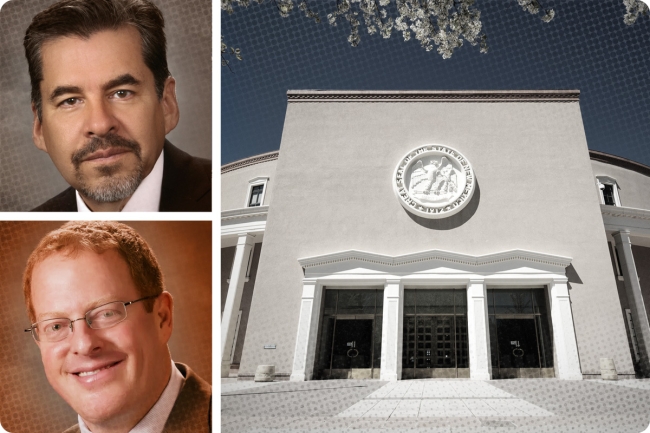You have /5 articles left.
Sign up for a free account or log in.

Senator Jeff Steinborn (bottom) proposed a joint resolution to add an extra step to the selection process for state university regents, but Senator Joseph Cervantes (top) blocked the bill from reaching the chamber floor.
Photo illustration by Justin Morrison/Inside Higher Ed | New Mexico Legislature | zrfphoto/iStock/Getty Images
New Mexico lawmakers have been trying for years to bring independent nominating committees into the process for selecting regents at each of the state’s seven public four-year institutions.
The effort seemed to gain momentum this year after two controversial incidents involving state college boards suggested the need for more oversight and less politicization of the process.
The incidents prompted a group of bipartisan state senators to call for a joint resolution that, if passed, would lead to a ballot proposition to amend the state Constitution to authorize creation of an advisory group to screen potential candidates and create a pool of approved nominees from which the governor can select.
The bill sailed through the Senate Rules Committee earlier this month, but the chairman of the Judiciary Committee refused to put it on the agenda, effectively killing the proposal. The 30-day legislative session ended last Thursday at noon.
Supporters of the constitutional amendment say it would weaken the governor’s unrestricted nomination powers and ensure the appointment of qualified candidates instead of wealthy political donors. But opponents worry it will create more bureaucracy and slow the nominating process.
Senator Jeff Steinborn, a Democrat and lead sponsor of the resolution, believes it would have had “overwhelming support” if it was presented to the Judiciary Committee and likely would have been passed by the Senate.
“It’s really just an enhancement to our current system, not a replacement of it,” Steinborn said. The governor would still be able to recommend any appointee they wanted, “and if their appointees are great they’ll end up making it … But if they don’t, then that would mean that a broad-based, nonpartisan group of people collectively felt like there were better candidates.”
But one lawmaker, Senator Joseph Cervantes, also a Democrat, was all it took to stop the proposal. Cervantes did not respond to a request for comment about why he did not bring the bill to the committee.
Steinborn described Cervantes’s ability to hold up the bill as “an unfortunate feature” of the state’s legislative system. He said he discussed the bill with Cervantes “many times,” to no avail.
“Respectfully, I don’t know that he’s fully thought it through, but I can’t speak for him,” Steinborn said.
There is general support among academics for the involvement of nominating committees in the regent or trustee selection process. But experts on higher ed governance say the practice is rarely implemented, because many politicians don’t want restraints on whom they can appoint.
The Association of Governing Boards of Universities and Colleges, or AGB, has published policy briefs supporting the establishment of nominating committees.
“If you want something other than past patronage to determine who is appointed to public governing boards, then there needs to be some kind of process,” said Ellen Chaffee, AGB’s interim president and CEO. “It matters who is on the board.”
“At the end of the day, it’s political,” she added. “Sometimes governors, or their party, simply don’t want their hands tied.”
Steinborn, who introduced similar proposals nine times from 2013 to 2021, said he plans to do so once again next year.
“We can’t afford to have anything other than the highest-quality leaders running our schools, hiring our university presidents,” he said. “So, yeah, we’ll keep fighting.”
Majority Support Despite Standstill
At the Rules Committee hearing for the resolution earlier this month, Mark Moores, a Republican and co-sponsor of the legislation, said there have been “some very political appointees” approved for state college governing boards in the past, who have “caused some tension.”
There has been heightened public interest in New Mexico State University’s board since the university paid an $8 million settlement last year following civil lawsuits by two members of the men’s basketball team who said they were hazed and sexually assaulted by teammates.
At the same time the settlement was being made, the university’s director of athletics, Mario Moccia, received a five-year contract extension and a raise of almost $72,000 over the course of those five years, boosting his annual salary to $371,800 this year and eventually to $425,000 by 2027.
The Board of Regents took no action in response.
Western New Mexico University’s regents also prompted concern and public criticism when they allowed university president Joseph Shepard, his wife and the chair of the board to spend university funds on trips to Greece, Spain and Zambia. The president says the trips were intended to attract international students, but local reporting by Searchlight New Mexico showed no cost-benefit analysis was conducted to gauge the value of trips abroad.
Senator Greg Nibert, a Republican and ranking member of the Rules Committee, said there would be value in “embedding local knowledge” in the board member selection process. The resolutions’ sponsors say it would likely include university faculty, administrators and staff, among others.
“Sometimes we have individuals that are being nominated that have no connection or prior understanding of the institution,” Nibert said. “We need some of that connection.”
Of the two Democratic senators who opposed adding an advisory committee to the process, only one, Gerald Ortiz y Pino, spoke at the hearing.
“I’m not sure this isn’t a solution in search of a problem,” he said.
Kim Sanchez Rael, chair of the University of New Mexico board, also opposed the idea.
“I feel like there is already a constitutional check and balance,” she said, referencing the requirement of Senate approval to appoint any one of the governor’s regent nominees. The addition of a nomination committee creates an unnecessary level of complexity and bureaucracy, she said.
‘Return on Investment’
Hawaii, Massachusetts, Minnesota, North Dakota and Virginia have implemented independent nomination committees for their public universities similar to the one proposed in New Mexico. Chaffee, from AGB, hopes more states will follow suit but said in addition to providing guidance on who should be nominated to boards, lawmakers must also be sure to provide guidance on what qualities the committees should look for in board nominees.
“It really is helpful if there’s a state philosophy about why we fund higher education that outlasts individuals in office,” she said. “And that can be institutionalized. If there’s a charter for the nominating committee, it provides a longer-term thread even when the people in the nominating committee change.”








